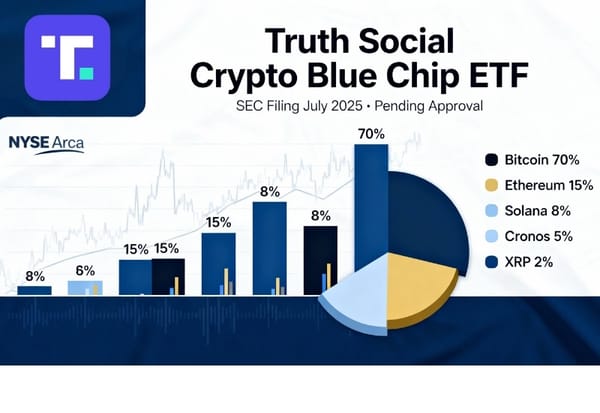JPMorgan Accepts Bitcoin & Ethereum Collateral: Wall Street's Crypto Pivot
JPMorgan will accept Bitcoin & Ethereum as loan collateral by year-end 2025, marking Wall Street's biggest crypto integration move yet as major banks race to offer digital asset services.

Lead
JPMorgan Chase, America's largest bank by market cap, will allow institutional clients to use Bitcoin and Ethereum as collateral for loans by year-end 2025, marking a watershed moment for digital asset integration into traditional finance. The global program, which relies on third-party custodians to safeguard pledged tokens, signals that cryptocurrencies are transitioning from speculative assets to legitimate financial instruments within the banking system's core infrastructure.
The Shift from Skepticism to Adoption
The initiative represents a dramatic pivot for JPMorgan and CEO Jamie Dimon, who previously dismissed Bitcoin as a "hyped-up fraud" and "pet rock." The bank now plans to treat cryptocurrency the same way it handles stocks, bonds, or gold in its lending operations. The program builds on JPMorgan's earlier move in June 2025 to accept crypto-linked ETFs as collateral, but takes it further by allowing clients to pledge the actual cryptocurrencies themselves.
JPMorgan initially explored Bitcoin-backed lending in 2022 but shelved the project due to regulatory uncertainty. Now, with rising institutional demand and clearer regulatory frameworks emerging globally, the bank is reviving and expanding these plans. The timing aligns with Bitcoin's recent rally to all-time highs above $110,000 and the Trump administration's more favorable stance toward digital assets.
Market-Wide Transformation Underway
JPMorgan's move is part of a broader Wall Street embrace of digital assets that's reshaping the financial landscape. Morgan Stanley plans to enable cryptocurrency trading on its E*Trade platform by Q2 2026, while State Street, BNY Mellon, and Fidelity have all expanded their crypto custody and settlement services. In July 2025, BNY Mellon partnered with Goldman Sachs to launch tokenized money market products for institutional clients.
Industry experts note this creates fundamental operational challenges for banks, requiring new risk frameworks including "dynamic margins, off-chain oracle feeds, and custodial risk insurance" as core requirements. Banks must now model 24/7 intraday volatility and exchange liquidity in real-time, a significant departure from traditional asset management.
Implications for Crypto Market Structure
The Federal Reserve's recent decision to fold crypto oversight into standard supervisory processes effectively mainstreams digital assets in the U.S. banking system, allowing crypto to be mobilized for lending, repo, and liquidity management. This regulatory clarity, combined with institutional adoption, fundamentally alters crypto's role in global finance.
The development enables institutions holding large crypto reserves to access liquidity without selling their assets, offering greater flexibility for short-term funding needs. This shift could influence where Bitcoin liquidity concentrates, as collateral acceptance by large dealers may keep coin balances on institutional books rather than in decentralized finance protocols.
The integration also introduces new systemic considerations. Once crypto can be used in repo markets, volatility in digital asset prices could ripple through collateral valuations and bank funding mechanisms, integrating crypto market swings into the broader credit system.
Conclusion
JPMorgan's crypto collateral program represents more than a single bank's policy change—it marks the formal integration of digital assets into Wall Street's lending infrastructure. As major financial institutions race to offer crypto services, we're witnessing the transformation of Bitcoin and Ethereum from alternative investments into recognized collateral assets alongside traditional securities. This development could accelerate institutional adoption, deepen crypto market liquidity, and fundamentally reshape how digital assets interact with the global financial system.
DISCLAIMER: This newsletter is for informational purposes only and does not constitute investment advice, advertising, or a recommendation to buy, sell, or hold any securities. This content is not sponsored by or affiliated with any of the mentioned entities. Investments in cryptocurrencies or other financial assets carry significant risks, including the potential for total loss, extreme volatility, and regulatory uncertainty. Past performance is not indicative of future results. Always consult a qualified financial professional and conduct thorough research before making any investment decisions.
Sources
- Bloomberg: JPMorgan to Allow Bitcoin and Ether as Collateral
- CoinDesk: JPMorgan to Allow Clients to Pledge Bitcoin and Ether as Collateral
- Decrypt: JPMorgan to Let Clients Use Bitcoin and Ether as Collateral for Loans
- The Crypto Basic: JPMorgan to Allow Major Clients Use Bitcoin, Ethereum as Loan Collateral
- American Banker: Crypto as Collateral Will Bring Digital Assets into the Mainstream



